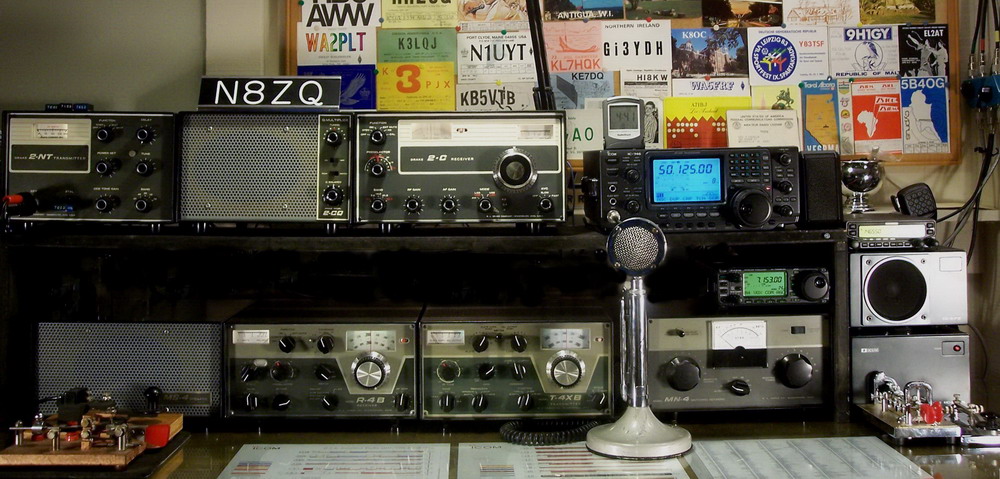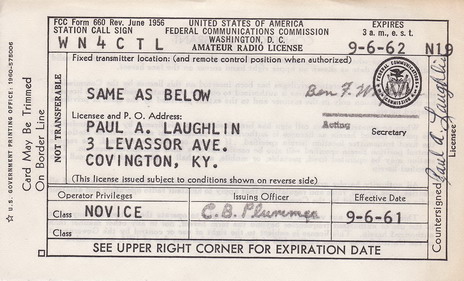






I'm what you'd best call a
casual operator. I don't chase DX (distant stations,
preferably in rare countries--
that is, those with few or no amateur radio operators, aka
"hams," living there), or try to win certificates by
collecting countries or counties or grid squares or other
sorts of numbers; nor do I try to bust through on-air
rare-station pile-ups to demonstrate my power, skill, or
manhood over other operators. (Sorry Dr. Freud!)
I also don't work, and generally loathe, amateur radio
contests (aka "radiosport"), because they often ruin
entire frequency bands for the casual operator for whole
weekends. What I do enjoy is "working" interesting
people who understand "QSO" not just as a hit-and-run contact, but as an actual
conversation--what in
the old days was honored as a "Ragchew," in which you get to
know the person.
Here is a photo of
my current station, more or less:

I say "more or less" because my
stations are always works in progress. To the left on both
levels are older tube
radios, 1970s vintage. On the lower level is the Drake
B-Line (R-4B receiver & R4XB transmitter, cabled
together to operate in transceive mode, using either the
transmitter's or the receiver's VFO (variable frequency
oscillator, or thing behind the dial that changes the
frequency) to keep both radios on the same frequency, or as
separates, to transmit and receive on different frequencies
(something that is done relatively rarely these days).
To the left of the R4B is the MS-4 speaker cabinet, which also
houses the power supply. To the right of the
T4XB is the MN-4 matching network (antenna tuner). Above the
B-Line are the Drake "Novice Twins":
the crystal-controlled 2-NT transmitter and, on the
other side of the 2-CQ speaker, the 2-C receiver.* The
crystals I use are the classic FT-243s, are "cut" to a
specific frequency, and look like this:

Both sets of Drake radios
are for the HF ("high frequency") bands, that is, those
between 1.8 and 30 Megahertz.
For hams, there are now ten such bands, up from only six
when I was a kid. They are 160 (which, at 1.8 Mhz
or
1800 KHz is just about your AM radio dial), 75/80, 60,
40, 30, 20, 17, 15, 12, and ten meter bands. The
word
"meter" there refers to the approximate wave-length of
the frequencies involved, and the rule is "the higher
the
frequency, the shorter the wavelength. Wavelength
becomes important practically because it determines the
length of the antenna that will be used on each
frequency band. Above the HF bands are the VHF bands,
which
for hams means 6 and two meters (50 and 144 Mhz) and UHF
(220 and 440 Mhz and, rarely, higher). VHF and
UHF are mostly for fairly local communications (except
under extraordinary and mostly unpredictable
conditions),
while the aforementioned HF bands are for distant (up to
world-wide!) contacts. HF and some VHF distance
(DX) communications are made possible because of the
effects of the sun (and especially sunspots) on the
ionosphere that envelops the earth above the atmosphere.
When the solar activity charges the ions in the
ionosphere--and again, the extent to which it does this
is about as predicatble as the weather (WX) at the
atmospheric level--radio waves then bounce off it one or
more times in a process called "skip." Under skip
conditions (CONDX), a ham can talk to stations anywhere
on the face of the earth with 1 watt or less, though
100 watts (the amount of power in a decent size light
bulb) is the most common, despite the fact that hams
allowed up to 1000 watts (or 1 kilowatt) on most of
their allotted frequncies. Some hams create artificial
skip
conditions by bouncing their signals off repeaters
(stations that take little signals from little antennas
and
rebroadcast them with more power and bigger antennas),
satellites, the moon, and even meteor showers.
Other hams now connect their radios via Internet links,
but many of us old timers in the hobby think that
this is cheating--and some of us do it anyway, because
it's fun. And that is what ham radio is mostly about:
fun. Commercial activities like advertising, sales, and
broadcasting music are strictly prohibited. Ham radio
experimentation has, however, led to many breakthroughs
in communication technology and thus to
commercially successful equipment. The major
manufacturers of amateur radio equipment today, for
example--the likes of Icom, Kenwood, Yaesu, Alinco, and
Ten Tec, and Elcraft--make a lot of money on
on amateur radio, but are not allowed to advertise on
the amateur radio bands. Some hams still make their
own equipment, and especially transmitters,
transceivers, and antennas either from kits or strictly
"homebrew."
The modern
equipment to the right in the photo is, on the top shelf,
an ICOM IC-746 HF/VHF transceiver
(idling at the moment on the 6-meter SSB** calling
frequency). To the right of it and sitting atop the Drake
antenna tuner, is an IC-706 MarkIIG transceiver, which
will probably become a mobile station for me soon.
(Hams, you see, can "work" the world from their cars,
boats, and aircraft.) Just to the right of the
IC-746
and sitting atop an ICOM speaker that is in turn atop the
ICOM power supply for the IC-706 is
a Kenwood TM-V71A VHF-UHF dual-band radio, which I keep in
the cross-band mode. This allows me
to use a tiny 440 MHz (70 centimeter) handheld transceiver
("handie-talkie") around the house and
neighborhood to transmit and receive on the more popular
144 MHz (2-meter) band, which is hooked up to
a Diamond X-50A dual-band vertical at 35 ft. above the
ground. (My other outdoor antennas are an
Inverted-Vee wire antenna for 40 meters, a Cushcraft R-5
tri-band vertical for 20 through 10 meters, and a
replica of the Saturn-6 Halo that I had on my Renault
Dauphin as a kid. Not pictured (because not installed
at the time of the photo) are the outboard DSP (Digital
Signal Professor) units I've installed for both Drake
receivers and the interface and laptop computer used with
the IC-746 to work the digital PSK-31 mode.
Actually, my
preferences of late have gone retro and low-tech. On
either side of the desk surface, is
a set of mechanical telegraph keys, one a pump-action
straight key, and the other a semi-automatic
("bug" or "speed key"), which makes the Morse Code "dits"
automatically with the thumb-side,
and "dahs" manually with the index-finger-side. [Note:
telegraphers do not think
in -terms of dots
[Note:
pictured
above are the keys currently on my operating table. The
top set are of my German Junker
("Younker") and my homebrew
"bug," with the Junker in its closed and open configurations,
the latter being
for adjustments in contact
spacings and spring tension. The bottom photo shows (l.
to r.) a Bencher Chrome
Delux straight
key, a Vibroplex Presentation semi-automatic key, and a Nye
Chrome Delux straight key.]
and dashes, but of
sounds. Amateur radiotelegraphy is
generally referred to as "CW," an abbre-
viation for "continuous wave," which in turn connotes
the pure tone that the key breaks into
"notes," as it were: quarter-note dahs and
eighth-note dits.
Proficiency in the Morse Code is no
longer required for amateur radio licenses, but many
hams use it as their mode of choice because is
relaxing and fun. Also, with an eye toward emergency
communications under difficult conditions
(like ambient atmospheric noise and interference from
other stations), CW is the most efficient,
effective, and reliable form of radio communication
there is; and in the hands of experts, it's
actually faster than text-messaging! (Watch this!)
If you would like to learn Morse Code, there
is an excellent (and free) training and practice program
available for downloading at:
http://www.g4fon.net/.
*The
R.
L. Drake Company of Miamisburg, Ohio, was the maker of
fine amateur radio and other electronic
equipment for many years, especially in the 1950s,
'60s, and 70's, when--together with the Collins Radio
Company--it was vying to be the "Cadillac" brand in ham gear
and succeeding in the minds of many. Even
Collins lovers had to concede that the Drake gear was at
least at the Lincoln-Continental level! Drake got
out of the amateur radio market in the late 70s, had a brief
foray back into it in the late '90s, but now--
relocated in Franklin, Ohio--specializes in Cable TV,
hearing assistance, and other electronic equipment.
**"SSB"
stands
for "single
side-band" (or just "side-band," for short), one of
three types of "phone" or
"fone" (voice/microphone) operation used in ham radio,
the other two being AM and
FM, which are
familiar to anyone who owns a broadcast radio. SSB reduces the
bandwidth of the signal--that is,
the amount of "room" it takes up on the dial, and concentrates the
power in the narrower frequency
"space" that it does occupy--which give you more
bang-for-the-watt, power-wise and
conserves space
on the band for others to use. ("Everybody's a weiner!") SSB
sounds weird--Donald-Ducky--on
anything but a SSB receiver.

Part 2: The Beginnings
I was first licensed in 1961
as WN4CTL/WA4CTL in Covington, Kentucky (Northern Kentucky,
the Greater Cincinnati Area). It is the amateur radio
license, issued by the Federal Communications
Commission (FCC) after an
examination on radio theory, radio wave propagation, and
operational
practices has been passed by the applicant, that
marks the most important difference between
amateur radio and CB, which used to require a no-test license,
but now is almost totally unregulated.
Here is my first novice
license:

This was back in the "good old
days" when novice licenses were for one year only and
non-renewable,
which meant that you had to upgrade quickly, at least to
Technician class (but preferably General),
or lose your callsign and all of your privileges. I
think that I recall correctly that you could then
reapply for a new Novice license and callsign after a waiting
period of a year or two.
This station photo
was taken early in 1962.

Note
the
white sox and Florsheim Italian boots, a sartorial disaster
even back then, and even in Kentucky.
We didn't have the words
"nerd" or "geek" back then, but if we had, and you had looked
up either word in
a dictionary, there would
have been a picture of me next to it. Later I did become
more hip, grew taller and
slimmed down (to 6'4" and
180 lbs.), and started wearing (I swear) tailor-made Italian
suits and sport coats
(one made of burgundy
mohair), all as a result of breaking into the jazz music
sub-culture that was at its peak
in Cincinnati in the early
to mid '60s. By the way, I paid for the clothes myself with
the money I
made from a part-time job and musical gigs.

The fact that I am holding a
microphone in the above station photo means that I had already
upgraded by
examination to a Technician Class license and had phone (short
for "microphone") privileges on six meters.
My first six-meter rig is pictured to the
far left, and was a 5-watt Lafayette HE-35 AM transceiver and
was crystal-
controlled, which was okay because most activity was on or
around 50.2 MHz (which were called "Megacycles"
in those days). Not long after this picture was taken, I
upgraded to a Lafayette HE-45A, which had an unstable
VFO (variable frequency oscillator, the dial-controlled
component that allows you to change frequencies) and
the option of a second, outboard, and equally unstable
VFO. I ran that AM rig as a base station and mobile
in my 1960 Renault Dauphin with a Saturn-6 Halo antenna on the
back bumper--the wind drag on which
would have tipped the Renault over backwards at 60 MPH, if the
Dauphin had been capable of that speed.
Immediately to the right of the
HE-35 are my first HF receivers, the old "Command Sets," which
were
WWII Army Air Corps surplus radios built for and used
extensively in the B-17 bomber. (They were
plentiful at Army Surplus stores in the 1950s and 60s. I think
I paid $5 for each of mine.) The black one was
the BC-454, which covered 3 to 6 MHz, and was good for 80
meters. The silver box next to it was the BC-455,
which covered 6 to 9.1 MHz, and therefore the 40-meter (7 MHz)
ham band. The sensitivity and selectivity
on these receivers was very good (literally "MIL SPEC"), but
the band spread for the novice frequencies on
the big metal dials on both radios was very narrow: a quarter
inch, perhaps. (These were the days, by the way,
when all Novices were required to be crystal-controlled, and
QSOs were rarely on exactly the same frequency.
In fact, you would call CQ on your own frequency, then
tune the entire novice band for any possible call.
There was a modification that improved that to about an inch,
but it required literally yanking out specific
metal plates in the variable capacitors with a pair of pliers.
There were matching transmitters for these
receivers, by the way. For 40 meters, for example, there was
the BC-459 (aka ARC-5). There was a
modification to make these XTAL-controlled (aka "rock-bound")
and legal for Novices, but many used
them with the VFO, knowing that they were so stable that after
about twenty minutes of warmup,
that almost nobody would be able to detect any drift in
frequency. These radio were built like tanks. You
could literally throw one across the street and put it right
back on the air. The only drawback to these radios
was that they were designed to be powers by 26-volt
dynamotors, so power supplies were a little tricky to build.
Mine was mounted in an old plastic table radio case, and
appears (partially) in the picture on top of the HF
transmitter with the "WN4CTL" callsign taped on it.
That transmitter
was a CW-only Globe Chief, which was also
crystal-controlled and covered 80-10 meters
(3-30 MHz). It was a fairly simple, but effective
design, and could be trouble-shot (?) and repaired very
easily.
When my Chief failed one day, for example, I took it out
of cabinet, hooked it up to a 100-watt light bulb
"dummy load," and probed the circuitry with a used (but
dry) Popsicle stick until the discontinuity--a bad
solder joint--was located. I "sweated" it with my
soldering iron (yes!) and it was good as new, and worked
swell until I traded it for its big brother, the Globe
Scout, which added to the Chief's design both
AM-phone and 6 meters.
Almost all VHF
activity was AM-phone in those days, at least in the
Midwest, though there was a
modicum of CW there as well.
[Note: (1)
Novices had limited phone privileges in those days, but hardly
anyone used them because VHF above
six meters (50 MHz) was a vast wasteland; and (2) a Tech still
had to use the WN or KN or in New York, New
Jersey, and California, the WV (don't ask) prefix when operating
the HF Novice frequencies.]

The Middle Years
After a period of inactivity
while I was building a family and a career, I became active in
amateur radio
again in 1982 as KA8QGR in Columbus, Ohio, where I had lived
since 1979, and within a few months
I upgraded to Advanced and Extra classes as KC8ZQ, under which
callsign I achieved Worked All Continents,
Worked All States, and DX Century Club (for working 100
countries or more) within a year. I kept
that callsign for about 15 years, by which time I was living
in nearby Westerville, Ohio.
Here is a 1985
(pre-digital) photo of me posing with my Columbus station,
and another of the station itself.


Here is a photo of the equipment at more of a front-on angle:

The vintage gear
here is on the table level and to the right. In this
case, it is a Collins "S-Line" that I had
found stored and gathering dust in the Physics Department
at my college, and that I borrowed with full
permission because I was the only ham on campus, and only
I could check it out to see if it worked. It did,
and beautifully. When another ham showed up on campus--Lou
Arnold (K9ALP), damn him!--I dutifully
returned it to the college and wept for days. It wasn't as
though I didn't have any equipment of my own left.
To the right in the picture are (at desk level) a
Hallicrafters SX-101 receiver and, above it, a Heathkit
DX-35
(I think, since the 20 and 40 looked just like it, and I
owned one of each. Still do, in fact, along with a
DX-60,
HW-8, and HW-16--all in storage.) Atop the DX-35 is a
speaker of some kind. On the shelf above the S-Line
is my first solid-state transceiver, an Icom IC-730,
which in some ways is my favorite radio ever. The
transceiver
itself is sitting up on its front "legs," and to its
left are, first, its automatic antenna tuner, and then
(next to the
TV) its power supply, which is on my desk today powering
an IC-706. The computer to the left is a Commodore
(aka "Commode Door") VIC-20, modified to work with
the Interface above it as a RTTY (radioteletype) station,
a mode that I enjoyed very much on HF and VHF. To the
right of the VIC-20 is an Electrovoice microphone,
a chrome Bencher iambic key and small black
electronic keyer attached (barely visible in front of the
brick
shelf support), and a WWII surplus J-38 straight key. Atop
the Icom antenna tuner is an MFJ Manual antenna
tuner for use mostly with the S-Line. To the very far left
at table level (and almost invisible) sits a Kenwood
TR-7850 on top of its Astron power supply. This was a fun
rig to operate, which I did until I had to give back
the S-line (which I replaced with a Collins KWM-2,
which I bought with its power supply at a hamfest.
As much fun as the radios and accessories were, I also
enjoyed the best antenna system I have ever had.
Check out a 39-year-old me standing on the chimney of my
Columbus house next to my fifty-foot tower.
I obviously was not up there to do any serious work on the
antennas, since I don't have a climbing belt on.



The antennas shown here are (on top) a Mosley MP-33 tribander
for 20, 15, and 10 meters and two
stacked 13-element 2-meter yagis, vertically polarized for DX
(distance) operations on FM. Both of
these antennas were rotatable and directional. Hanging
from a short arm off the towers are two
inverted Vee (wire) antennas for 40 and 30 meters, sharing a
single feedpoint and feedline. Visible in the
upper right quadrant of the first photo is a portion of
a Slinky dipole antenna for 75 and 80 meters (so-
named because it was made from two large Slinkies designed for
amateur radio antennas for small lots
and attics--to provide greater electrical-length antennas for
lower HF freqencies where the physically
longer antenna simply would not fit). Almost invisible behind
the leaves in photo two is a Ringo
Ranger II verical antenna for 2-meters (144 MHz) strapped to
the little chimney.
In 1997, seven
years after moving to Westerville, under the recently
established
"vanity" program I changed my callsign to N8ZQ because it
was shorter and
had a better rhythm on CW--two measures in a
"marchy" 4/4 time, in fact.
In mid-2011, I
divorced my second and estranged wife, and married my
present XYL (the third,
the best, and I swear the last, Mrs. Laughlin), Donna,
WA3ZBU, whom I had first met on the air
in 1983--when both of us were otherwise spoken for. Our
home is in the Upper Arlington area
of Columbus, Ohio.
The following two
photos were taken New Year's Eve, 2012, during an annual
amateur radio
event called "Straight Key Night." We were operating under
the Otterbein College/University
callsign K8OC. Not long after that event, we went on a
Weight Watcher's regime, and lost
a combined total of 120 pounds in 2013!
Donna and I
share a shack with some current but mostly vintage
equipment,
and we have put up some modest, but very effective
antennas. The shack
looks something like this:
Donna and I both
enjoy CW (radiotelegraphy), SSB on HF, and chatting with
our local friends
on 2-meters either from our respective cars or from our
house, where we have a 2-meter/440 MHz.
dual-band repeater hooked up to a Diamond dual-band
vertical at about 50 feet, which we access
with four or five little Alinco 440 hand-helds
around the house. I'm also itching to get us set up
for PSK31, a mode I worked and enjoyed for several years
while I was living in Westerville.
And that brings us
pretty much back to present.

For those of you who may have
started here, rather than on my personal homepage,
I am a college professor by trade, and teach mostly
comparative religions, Eastern
philosophies, and Religion in America at Otterbein College in
Westerville. I write and
publish extensively, mostly scholarly articles in the areas of
American metaphysical
religion and Constructive Theology. My latest books for a
popular market are:
Remedial Christianity:
What Every Believer Should Know about the Faith, but
Probably
Doesn't (Polebridge Press, 2000) and Getting Oriented: What Every
Christian Should
Know about Eastern Religions, but Probably Doesn't (Polebridge
Press,
2005), both
available through amazon.com. You can check out my personal
and professional life
at: http://laughlinonline.net/homepaulblue.html,
and a slice of my life as a jazz
musician (and a father!) at http://www.youtube.com/watch?v=zauXqsyMHCc.
E-mail: N8ZQ@arrl.net or palaughlin@gmail.com



 Back to Paul's Home Page
Back to Paul's Home Page
